warning lights HONDA CR-V 2016 RM1, RM3, RM4 / 4.G Quick Guide
[x] Cancel search | Manufacturer: HONDA, Model Year: 2016, Model line: CR-V, Model: HONDA CR-V 2016 RM1, RM3, RM4 / 4.GPages: 80, PDF Size: 7.99 MB
Page 4 of 80
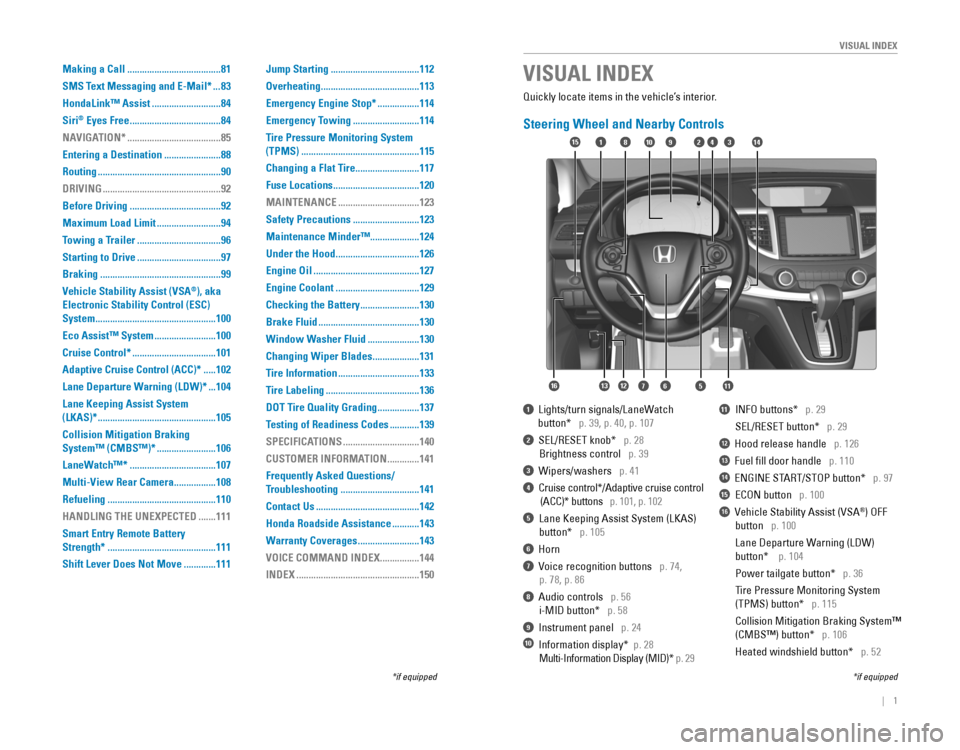
| 1
VISUAL INDEX
Quickly locate items in the vehicle’s interior.
Steering Wheel and Nearby Controls
1‚ÄÇ‚ÄÇLights/turn‚ÄÇsignals/LaneWatch
‚ÄÇ‚ÄÇ‚ÄÇ‚ÄÇ‚ÄÇ‚ÄÇbutton*‚ÄÇ‚ÄÇ‚ÄÇp.‚ÄÇ39,‚ÄÇp.‚ÄÇ40,‚ÄÇp.‚ÄÇ107
2‚ÄÇ‚ÄÇSEL/RESET‚ÄÇknob*‚ÄÇ‚ÄÇ‚ÄÇp. 28
Brightness control p. 39
3‚ÄÇ‚ÄÇWipers/washers‚ÄÇ‚ÄÇ‚ÄÇp.‚ÄÇ41
4‚ÄÇ‚ÄÇCruise‚ÄÇcontrol*/Adaptive‚ÄÇcruise‚ÄÇcontrol‚ÄÇ‚ÄÇ
‚ÄÇ(ACC)*‚ÄÇbuttons‚ÄÇ‚ÄÇ‚ÄÇp. 101, p. 102
5 Lane Keeping Assist System (LKAS)
‚ÄÇbutton* p. 105
6 Horn
7‚ÄÇ‚ÄÇVoice‚ÄÇrecognition‚ÄÇbuttons‚ÄÇ‚ÄÇ‚ÄÇp.‚ÄÇ74,
‚ÄÇp.‚ÄÇ78,‚ÄÇp.‚ÄÇ86
8 Audio controls p. 56
i-MID‚ÄÇbutton*‚ÄÇ‚ÄÇ‚ÄÇp. 58
9‚ÄÇ‚ÄÇInstrument‚ÄÇpanel‚ÄÇ‚ÄÇ‚ÄÇp.‚ÄÇ24
10‚ÄÇ‚ÄÇInformation‚ÄÇdisplay*‚ÄÇ‚ÄÇp. 28
‚ÄÇMulti-Information‚ÄÇDisplay‚ÄÇ(MID)*‚ÄÇp. 29
11‚ÄÇ‚ÄÇ‚ÄÇINFO‚ÄÇbuttons*‚ÄÇ‚ÄÇ‚ÄÇp. 29
SEL/RESET‚ÄÇbutton*‚ÄÇ‚ÄÇ‚ÄÇp. 29
12 Hood release handle p. 126
13 Fuel fill door handle p. 110
14‚ÄÇ‚ÄÇENGINE‚ÄÇSTART/STOP‚ÄÇbutton*‚ÄÇ‚ÄÇ‚ÄÇp.‚ÄÇ97
15 ECON‚ÄÇbutton p. 100
16  Vehicle Stability Assist (VSA®) OFF
‚ÄÇbutton‚ÄÇ‚ÄÇ‚ÄÇp. 100
‚ÄÇLane‚ÄÇDeparture‚ÄÇWarning‚ÄÇ(LDW)‚ÄÇ‚ÄÇ ‚ÄÇ
‚ÄÇbutton*‚ÄÇ‚ÄÇ‚ÄÇ‚ÄÇp.‚ÄÇ104
‚ÄÇPower‚ÄÇtailgate‚ÄÇbutton*‚ÄÇ‚ÄÇ‚ÄÇp. 36
Tire Pressure Monitoring System
‚ÄÇ(TPMS)‚ÄÇbutton*‚ÄÇ‚ÄÇ‚ÄÇp. 115
Collision Mitigation Braking System‚Ñ¢
‚ÄÇ(CMBS‚Ñ¢)‚ÄÇbutton*‚ÄÇ‚ÄÇ‚ÄÇp. 106
‚ÄÇHeated‚ÄÇwindshield‚ÄÇbutton*‚ÄÇ‚ÄÇ‚ÄÇp. 52
VISUAL INDEX
*if‚ÄÇequipped*if‚ÄÇequipped
92
567111213
1815341014
16
Making a Call ......................................81
SMS Text Messaging and E-Mail*
...83
HondaLink‚Ñ¢ Assist
............................84
Siri
® Eyes Free .....................................84
NAVIGATION*
......................................85
Entering a Destination
.......................88
Routing
..................................................90
DRIVING
................................................92
Before Driving
.....................................92
Maximum Load Limit
..........................94
Towing a Trailer
..................................96
Starting to Drive
..................................97
Braking
.................................................99
Vehicle Stability Assist (VSA
®), aka
Electronic Stability Control (ESC)
System
.................................................100
Eco Assist‚Ñ¢ System
.........................100
Cruise Control*
..................................101
Adaptive Cruise Control (ACC)*
.....102
Lane Departure Warning (LDW)*
...104
Lane Keeping Assist System
(LKAS)*
................................................105
Collision Mitigation Braking
System‚Ñ¢ (CMBS‚Ñ¢)*
........................106
LaneWatch‚Ñ¢*
...................................107
Multi-View Rear Camera
.................108
Refueling
............................................110
HANDLING THE UNEXPECTED
.......111
Smart Entry Remote Battery
Strength*
............................................111
Shift Lever Does Not Move
.............111 Jump Starting
....................................112
Overheating
........................................113
Emergency Engine Stop*
.................114
Emergency Towing
...........................114
Tire Pressure Monitoring System
(TPMS)
................................................115
Changing a Flat Tire
..........................117
Fuse Locations
...................................120
MAINTENANCE
.................................123
Safety Precautions
...........................123
Maintenance Minder‚Ñ¢ ....................124
Under the Hood
..................................126
Engine Oil
...........................................127
Engine Coolant
..................................129
Checking the Battery
........................130
Brake Fluid
.........................................130
Window Washer Fluid
.....................130
Changing Wiper Blades
...................131
Tire Information
.................................133
Tire Labeling
......................................136
DOT Tire Quality Grading
.................137
Testing of Readiness Codes
............139
SPECIFICATIONS
...............................140
CUSTOMER INFORMATION
.............141
Frequently Asked Questions/
Troubleshooting
................................141
Contact Us
..........................................142
Honda Roadside Assistance
...........143
Warranty Coverages
.........................143
VOICE COMMAND INDEX
................144
INDEX
..................................................150
Page 23 of 80
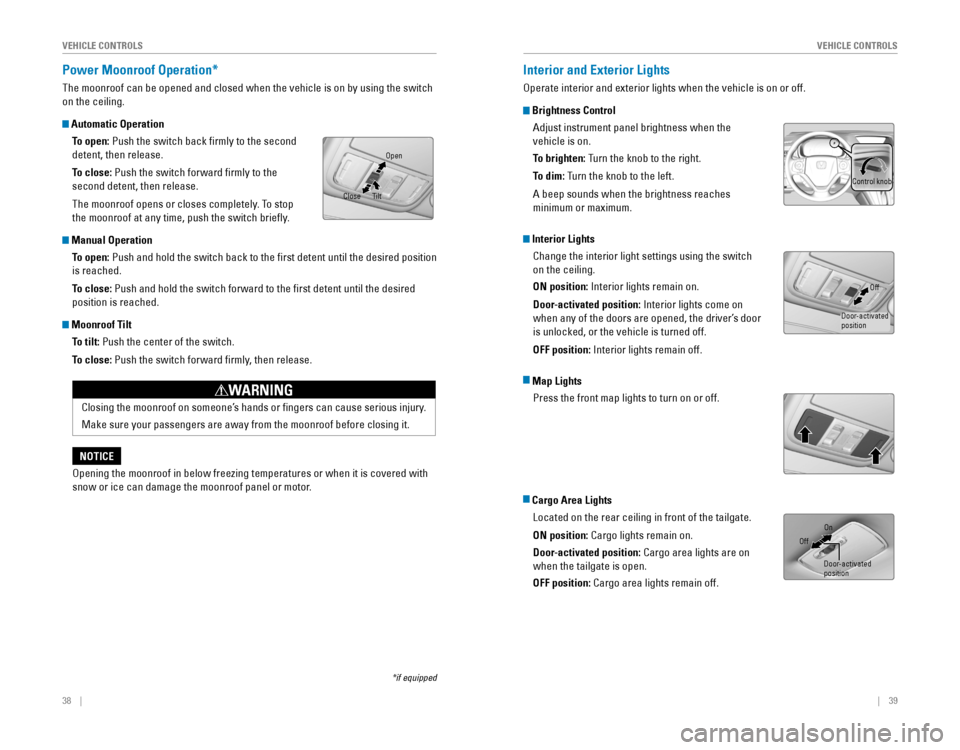
38 || 39
V
EHICLE CONTROLSVEHICLE CONTROLS
Power Moonroof Operation*
The‚ÄÇmoonroof‚ÄÇcan‚ÄÇbe‚ÄÇopened‚ÄÇand‚ÄÇclosed‚ÄÇwhen‚ÄÇthe‚ÄÇvehicle‚ÄÇis‚ÄÇon‚ÄÇby‚ÄÇusing‚ÄÇthe‚ÄÇswitch‚ÄÇ
on the ceiling.
Automatic Operation
To open:
‚ÄÇPush‚ÄÇthe‚ÄÇswitch‚ÄÇback‚ÄÇfirmly‚ÄÇto‚ÄÇthe‚ÄÇsecond‚ÄÇ
detent, then release.
To close: Push the switch forward firmly to the
second detent, then release.
The moonroof opens or closes completely. To stop
the‚ÄÇmoonroof‚ÄÇat‚ÄÇany‚ÄÇtime,‚ÄÇpush‚ÄÇthe‚ÄÇswitch‚ÄÇbriefly.
Manual OperationTo open:
‚ÄÇPush‚ÄÇand‚ÄÇhold‚ÄÇthe‚ÄÇswitch‚ÄÇback‚ÄÇto‚ÄÇthe‚ÄÇfirst‚ÄÇdetent‚ÄÇuntil‚ÄÇthe‚ÄÇdesired‚ÄÇposition‚ÄÇ
is reached.
To close: Push and hold the switch forward to the first detent until the desire\
d
position is reached.
Moonroof TiltTo tilt: Push the center of the switch.
To close: Push the switch forward firmly, then release.
*if‚ÄÇequipped
Interior and Exterior Lights
Operate interior and exterior lights when the vehicle is on or off.
Brightness Control
Adjust‚ÄÇinstrument‚ÄÇpanel‚ÄÇbrightness‚ÄÇwhen‚ÄÇthe‚ÄÇ
vehicle is on.
To brighten:
‚ÄÇTurn‚ÄÇthe‚ÄÇknob‚ÄÇto‚ÄÇthe‚ÄÇright.
To dim:‚ÄÇTurn‚ÄÇthe‚ÄÇknob‚ÄÇto‚ÄÇthe‚ÄÇleft.
A‚ÄÇbeep‚ÄÇsounds‚ÄÇwhen‚ÄÇthe‚ÄÇbrightness‚ÄÇreaches‚ÄÇ
minimum or maximum.
Interior LightsChange the interior light settings using the switch
on the ceiling.
ON position:
‚ÄÇInterior‚ÄÇlights‚ÄÇremain‚ÄÇon.
Door-activated position:‚ÄÇInterior‚ÄÇlights‚ÄÇcome‚ÄÇon‚ÄÇ
when any of the doors are opened, the driver’s door
is unlocked, or the vehicle is turned off.
OFF position:
‚ÄÇInterior‚ÄÇlights‚ÄÇremain‚ÄÇoff.
Map LightsPress the front map lights to turn on or off.
Cargo Area LightsLocated on the rear ceiling in front of the tailgate.
ON position: Cargo lights remain on.
Door-activated position: Cargo area lights are on
when the tailgate is open.
OFF position: Cargo area lights remain off.
Close Open
Tilt
Closing the moonroof on someone’s hands or fingers can cause serious injury.
Make‚ÄÇsure‚ÄÇyour‚ÄÇpassengers‚ÄÇare‚ÄÇaway‚ÄÇfrom‚ÄÇthe‚ÄÇmoonroof‚ÄÇbefore‚ÄÇclosing‚ÄÇit.
WARNING
Opening‚ÄÇthe‚ÄÇmoonroof‚ÄÇin‚ÄÇbelow‚ÄÇfreezing‚ÄÇtemperatures‚ÄÇor‚ÄÇwhen‚ÄÇit‚ÄÇis‚ÄÇcovered‚ÄÇwith‚ÄÇ
snow or ice can damage the moonroof panel or motor.
NOTICE
Control‚ÄÇknob
Off
Door-activated
position
Door-activated
position On
Off
Page 28 of 80
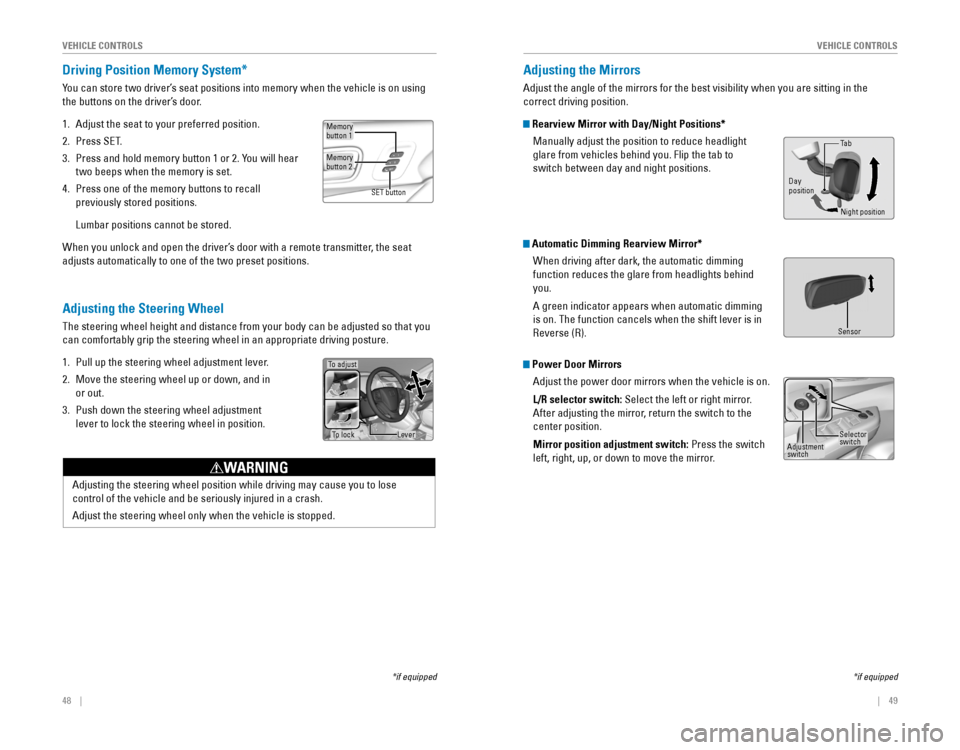
48‚ÄÇ‚ÄÇ‚ÄÇ‚ÄÇ||‚ÄÇ‚ÄÇ‚ÄÇ‚ÄÇ49
V
EHICLE CONTROLSVEHICLE CONTROLS
Adjusting the Steering Wheel
The‚ÄÇsteering‚ÄÇwheel‚ÄÇheight‚ÄÇand‚ÄÇdistance‚ÄÇfrom‚ÄÇyour‚ÄÇbody‚ÄÇcan‚ÄÇbe‚ÄÇadjusted‚ÄÇso‚ÄÇthat‚ÄÇyou‚ÄÇ
can‚ÄÇcomfortably‚ÄÇgrip‚ÄÇthe‚ÄÇsteering‚ÄÇwheel‚ÄÇin‚ÄÇan‚ÄÇappropriate‚ÄÇdriving‚ÄÇposture.
1. Pull up the steering wheel adjustment lever.
2. Move the steering wheel up or down, and in
or out.
3. Push down the steering wheel adjustment
lever to lock the steering wheel in position.
Driving Position Memory System*
You can store two driver’s seat positions into memory when the vehicle is on using
the buttons on the driver’s door.
1. Adjust the seat to your preferred position.
2. Press‚ÄÇSET.
3. Press‚ÄÇand‚ÄÇhold‚ÄÇmemory‚ÄÇbutton‚ÄÇ1‚ÄÇor‚ÄÇ2.‚ÄÇYou‚ÄÇwill‚ÄÇhear‚ÄÇ
two‚ÄÇbeeps‚ÄÇwhen‚ÄÇthe‚ÄÇmemory‚ÄÇis‚ÄÇset.
4.‚ÄÇPress‚ÄÇone‚ÄÇof‚ÄÇthe‚ÄÇmemory‚ÄÇbuttons‚ÄÇto‚ÄÇrecall‚ÄÇ
previously stored positions.
Lumbar‚ÄÇpositions‚ÄÇcannot‚ÄÇbe‚ÄÇstored.
When you unlock and open the driver’s door with a remote transmitter, the seat
adjusts automatically to one of the two preset positions.
*if‚ÄÇequipped
To adjust
To lockLever
*if‚ÄÇequipped
Adjusting the Mirrors
Adjust‚ÄÇthe‚ÄÇangle‚ÄÇof‚ÄÇthe‚ÄÇmirrors‚ÄÇfor‚ÄÇthe‚ÄÇbest‚ÄÇvisibility‚ÄÇwhen‚ÄÇyou‚ÄÇare‚ÄÇsitting‚ÄÇin‚ÄÇthe‚ÄÇ
correct driving position.
Rearview Mirror with Day/Night Positions*
Manually adjust the position to reduce headlight
glare‚ÄÇfrom‚ÄÇvehicles‚ÄÇbehind‚ÄÇyou.‚ÄÇFlip‚ÄÇthe‚ÄÇtab‚ÄÇto‚ÄÇ
switch‚ÄÇbetween‚ÄÇday‚ÄÇand‚ÄÇnight‚ÄÇpositions.
Automatic Dimming Rearview Mirror*When driving after dark, the automatic dimming
function‚ÄÇreduces‚ÄÇthe‚ÄÇglare‚ÄÇfrom‚ÄÇheadlights‚ÄÇbehind‚ÄÇ
you.
A green indicator appears when automatic dimming
is on. The function cancels when the shift lever is in
Reverse (R).
Power Door MirrorsAdjust the power door mirrors when the vehicle is on.
L/R selector switch: Select the left or right mirror.
After adjusting the mirror, return the switch to the
center position.
Mirror position adjustment switch: Press the switch
left, right, up, or down to move the mirror.
Memorybutton‚ÄÇ1
Memorybutton‚ÄÇ2
SET‚ÄÇbutton
Adjusting the steering wheel position while driving may cause you to los\
e
control‚ÄÇof‚ÄÇthe‚ÄÇvehicle‚ÄÇand‚ÄÇbe‚ÄÇseriously‚ÄÇinjured‚ÄÇin‚ÄÇa‚ÄÇcrash.
Adjust the steering wheel only when the vehicle is stopped.
WARNING
Night position
Ta b
Day
position
Sensor
Adjustment
switch
Selector
switch
Page 50 of 80
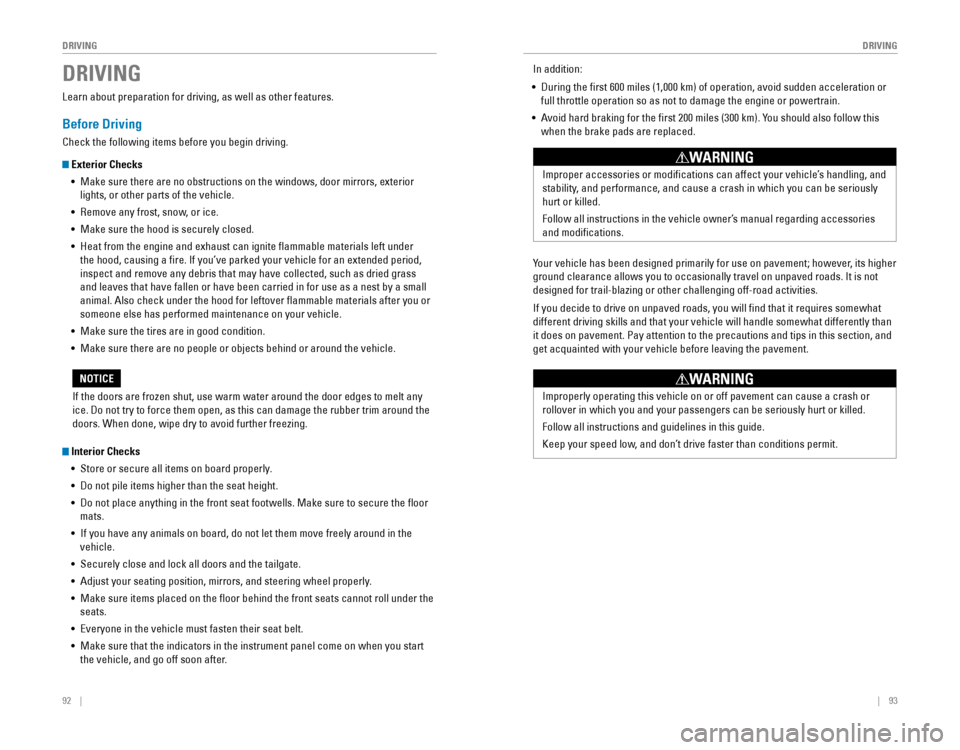
92 || 93
DRIVING
DRIVING
Learn‚ÄÇabout‚ÄÇpreparation‚ÄÇfor‚ÄÇdriving,‚ÄÇas‚ÄÇwell‚ÄÇas‚ÄÇother‚ÄÇfeatures.
Before Driving
Check‚ÄÇthe‚ÄÇfollowing‚ÄÇitems‚ÄÇbefore‚ÄÇyou‚ÄÇbegin‚ÄÇdriving.
Exterior Checks
• 
Make‚ÄÇsure‚ÄÇthere‚ÄÇare‚ÄÇno‚ÄÇobstructions‚ÄÇon‚ÄÇthe‚ÄÇwindows,‚ÄÇdoor‚ÄÇmirrors,‚ÄÇexterior‚ÄÇ
lights, or other parts of the vehicle.
•  Remove any frost, snow, or ice.
•  Make sure the hood is securely closed.
• 
Heat‚ÄÇfrom‚ÄÇthe‚ÄÇengine‚ÄÇand‚ÄÇexhaust‚ÄÇcan‚ÄÇignite‚ÄÇflammable‚ÄÇmaterials‚ÄÇleft‚ÄÇunder‚ÄÇ
the hood, causing a fire. If you’ve parked your vehicle for an extended period, 
inspect‚ÄÇand‚ÄÇremove‚ÄÇany‚ÄÇdebris‚ÄÇthat‚ÄÇmay‚ÄÇhave‚ÄÇcollected,‚ÄÇsuch‚ÄÇas‚ÄÇdried‚ÄÇgrass‚ÄÇ
and‚ÄÇleaves‚ÄÇthat‚ÄÇhave‚ÄÇfallen‚ÄÇor‚ÄÇhave‚ÄÇbeen‚ÄÇcarried‚ÄÇin‚ÄÇfor‚ÄÇuse‚ÄÇas‚ÄÇa‚ÄÇnest‚ÄÇby‚ÄÇa‚ÄÇsmall‚ÄÇ
animal.‚ÄÇAlso‚ÄÇcheck‚ÄÇunder‚ÄÇthe‚ÄÇhood‚ÄÇfor‚ÄÇleftover‚ÄÇflammable‚ÄÇmaterials‚ÄÇafter‚ÄÇyou‚ÄÇor‚ÄÇ
someone else has performed maintenance on your vehicle.
•  Make sure the tires are in good condition.
• 
Make‚ÄÇsure‚ÄÇthere‚ÄÇare‚ÄÇno‚ÄÇpeople‚ÄÇor‚ÄÇobjects‚ÄÇbehind‚ÄÇor‚ÄÇaround‚ÄÇthe‚ÄÇvehicle.
DRIVING
If‚ÄÇthe‚ÄÇdoors‚ÄÇare‚ÄÇfrozen‚ÄÇshut,‚ÄÇuse‚ÄÇwarm‚ÄÇwater‚ÄÇaround‚ÄÇthe‚ÄÇdoor‚ÄÇedges‚ÄÇto‚ÄÇmelt‚ÄÇany‚ÄÇ
ice.‚ÄÇDo‚ÄÇnot‚ÄÇtry‚ÄÇto‚ÄÇforce‚ÄÇthem‚ÄÇopen,‚ÄÇas‚ÄÇthis‚ÄÇcan‚ÄÇdamage‚ÄÇthe‚ÄÇrubber‚ÄÇtrim‚ÄÇaround‚ÄÇthe‚ÄÇ
doors.‚ÄÇWhen‚ÄÇdone,‚ÄÇwipe‚ÄÇdry‚ÄÇto‚ÄÇavoid‚ÄÇfurther‚ÄÇfreezing.
NOTICE
Improper accessories or modifications can affect your vehicle’s handling, and 
stability,‚ÄÇand‚ÄÇperformance,‚ÄÇand‚ÄÇcause‚ÄÇa‚ÄÇcrash‚ÄÇin‚ÄÇwhich‚ÄÇyou‚ÄÇcan‚ÄÇbe‚ÄÇseriously‚ÄÇ
hurt or killed.
Follow all instructions in the vehicle owner’s manual regarding accessories
and modifications.
WARNING
In‚ÄÇaddition:
• During the first 600 miles (1,000 km) of operation, avoid sudden acceleration or 
full throttle operation so as not to damage the engine or powertrain.
• 
Avoid‚ÄÇhard‚ÄÇbraking‚ÄÇfor‚ÄÇthe‚ÄÇfirst‚ÄÇ200‚ÄÇmiles‚ÄÇ(300‚ÄÇkm).‚ÄÇYou‚ÄÇshould‚ÄÇalso‚ÄÇfollow‚ÄÇthis‚ÄÇ
when‚ÄÇthe‚ÄÇbrake‚ÄÇpads‚ÄÇare‚ÄÇreplaced.
Your‚ÄÇvehicle‚ÄÇhas‚ÄÇbeen‚ÄÇdesigned‚ÄÇprimarily‚ÄÇfor‚ÄÇuse‚ÄÇon‚ÄÇpavement;‚ÄÇhowever,‚ÄÇits‚ÄÇhigher‚ÄÇ
ground‚ÄÇclearance‚ÄÇallows‚ÄÇyou‚ÄÇto‚ÄÇoccasionally‚ÄÇtravel‚ÄÇon‚ÄÇunpaved‚ÄÇroads.‚ÄÇIt‚ÄÇis‚ÄÇnot‚ÄÇ
designed‚ÄÇfor‚ÄÇtrail-blazing‚ÄÇor‚ÄÇother‚ÄÇchallenging‚ÄÇoff-road‚ÄÇactivities.
If‚ÄÇyou‚ÄÇdecide‚ÄÇto‚ÄÇdrive‚ÄÇon‚ÄÇunpaved‚ÄÇroads,‚ÄÇyou‚ÄÇwill‚ÄÇfind‚ÄÇthat‚ÄÇit‚ÄÇrequires‚ÄÇsomewhat‚ÄÇ
different driving skills and that your vehicle will handle somewhat diff\
erently than
it does on pavement. Pay attention to the precautions and tips in this s\
ection, and
get‚ÄÇacquainted‚ÄÇwith‚ÄÇyour‚ÄÇvehicle‚ÄÇbefore‚ÄÇleaving‚ÄÇthe‚ÄÇpavement.
Improperly‚ÄÇoperating‚ÄÇthis‚ÄÇvehicle‚ÄÇon‚ÄÇor‚ÄÇoff‚ÄÇpavement‚ÄÇcan‚ÄÇcause‚ÄÇa‚ÄÇcrash‚ÄÇor‚ÄÇ
rollover‚ÄÇin‚ÄÇwhich‚ÄÇyou‚ÄÇand‚ÄÇyour‚ÄÇpassengers‚ÄÇcan‚ÄÇbe‚ÄÇseriously‚ÄÇhurt‚ÄÇor‚ÄÇkilled.
Follow all instructions and guidelines in this guide.
Keep your speed low, and don’t drive faster than conditions permit.
WARNING
Interior Checks • 
Store‚ÄÇor‚ÄÇsecure‚ÄÇall‚ÄÇitems‚ÄÇon‚ÄÇboard‚ÄÇproperly.
• Do not pile items higher than the seat height.
• Do not place anything in the front seat footwells. Make sure to secure the floor 
mats.
• 
If‚ÄÇyou‚ÄÇhave‚ÄÇany‚ÄÇanimals‚ÄÇon‚ÄÇboard,‚ÄÇdo‚ÄÇnot‚ÄÇlet‚ÄÇthem‚ÄÇmove‚ÄÇfreely‚ÄÇaround‚ÄÇin‚ÄÇthe‚ÄÇ
vehicle.
•  Securely close and lock all doors and the tailgate.
•  Adjust your seating position, mirrors, and steering wheel properly.
• 
Make‚ÄÇsure‚ÄÇitems‚ÄÇplaced‚ÄÇon‚ÄÇthe‚ÄÇfloor‚ÄÇbehind‚ÄÇthe‚ÄÇfront‚ÄÇseats‚ÄÇcannot‚ÄÇroll‚ÄÇunder‚ÄÇthe‚ÄÇ
seats.
• 
Everyone‚ÄÇin‚ÄÇthe‚ÄÇvehicle‚ÄÇmust‚ÄÇfasten‚ÄÇtheir‚ÄÇseat‚ÄÇbelt.
•  Make sure that the indicators in the instrument panel come on when you s\
tart
the vehicle, and go off soon after.
Page 52 of 80
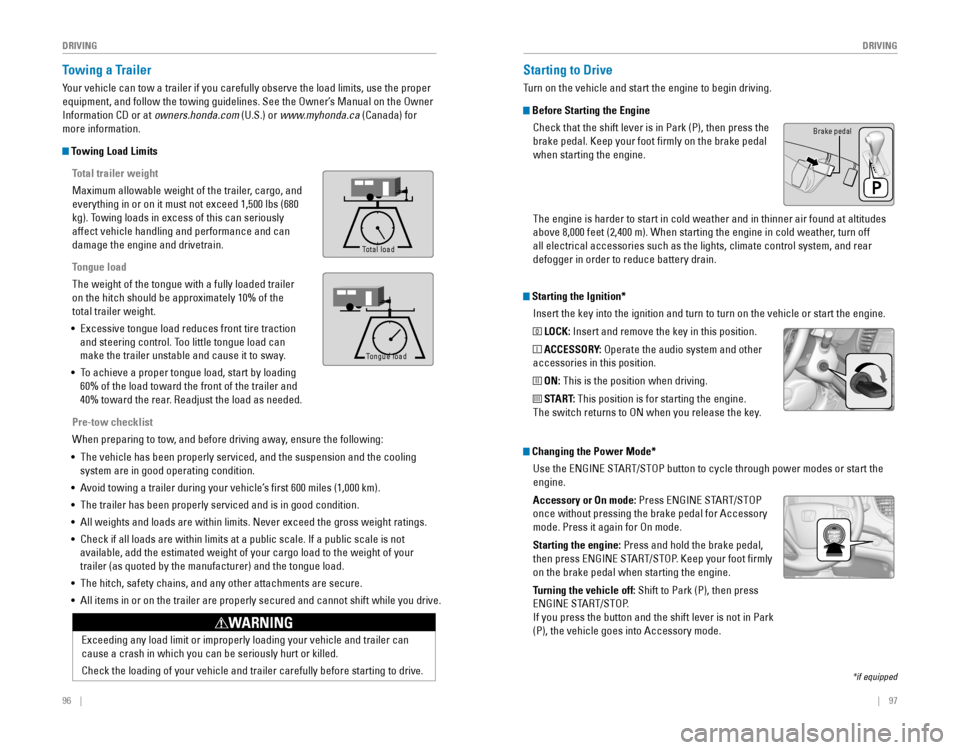
96 ||‚ÄÇ‚ÄÇ‚ÄÇ‚ÄÇ97
DRIVING
DRIVING
Exceeding‚ÄÇany‚ÄÇload‚ÄÇlimit‚ÄÇor‚ÄÇimproperly‚ÄÇloading‚ÄÇyour‚ÄÇvehicle‚ÄÇand‚ÄÇtrailer‚ÄÇcan‚ÄÇ
cause‚ÄÇa‚ÄÇcrash‚ÄÇin‚ÄÇwhich‚ÄÇyou‚ÄÇcan‚ÄÇbe‚ÄÇseriously‚ÄÇhurt‚ÄÇor‚ÄÇkilled.
Check‚ÄÇthe‚ÄÇloading‚ÄÇof‚ÄÇyour‚ÄÇvehicle‚ÄÇand‚ÄÇtrailer‚ÄÇcarefully‚ÄÇbefore‚ÄÇstarting‚ÄÇto‚ÄÇdrive.
WARNING
Towing a Trailer
Your‚ÄÇvehicle‚ÄÇcan‚ÄÇtow‚ÄÇa‚ÄÇtrailer‚ÄÇif‚ÄÇyou‚ÄÇcarefully‚ÄÇobserve‚ÄÇthe‚ÄÇload‚ÄÇlimits,‚ÄÇuse‚ÄÇthe‚ÄÇproper‚ÄÇ
equipment, and follow the towing guidelines. See the Owner’s Manual on the Owner 
Information‚ÄÇCD‚ÄÇor‚ÄÇat‚ÄÇowners.honda.com (U.S.) or www.myhonda.ca (Canada) for
more information.
Towing Load Limits
Total trailer weight
Maximum‚ÄÇallowable‚ÄÇweight‚ÄÇof‚ÄÇthe‚ÄÇtrailer,‚ÄÇcargo,‚ÄÇand‚ÄÇ
everything‚ÄÇin‚ÄÇor‚ÄÇon‚ÄÇit‚ÄÇmust‚ÄÇnot‚ÄÇexceed‚ÄÇ1,500‚ÄÇlbs‚ÄÇ(680‚ÄÇ
kg). Towing loads in excess of this can seriously
affect vehicle handling and performance and can
damage the engine and drivetrain.
Tongue load
The weight of the tongue with a fully loaded trailer
on‚ÄÇthe‚ÄÇhitch‚ÄÇshould‚ÄÇbe‚ÄÇapproximately‚ÄÇ10%‚ÄÇof‚ÄÇthe‚ÄÇ
total trailer weight.
• 
Excessive‚ÄÇtongue‚ÄÇload‚ÄÇreduces‚ÄÇfront‚ÄÇtire‚ÄÇtraction‚ÄÇ
and steering control. Too little tongue load can
make‚ÄÇthe‚ÄÇtrailer‚ÄÇunstable‚ÄÇand‚ÄÇcause‚ÄÇit‚ÄÇto‚ÄÇsway.
• To achieve a proper tongue load, start by loading 
60%‚ÄÇof‚ÄÇthe‚ÄÇload‚ÄÇtoward‚ÄÇthe‚ÄÇfront‚ÄÇof‚ÄÇthe‚ÄÇtrailer‚ÄÇand‚ÄÇ
40%‚ÄÇtoward‚ÄÇthe‚ÄÇrear.‚ÄÇReadjust‚ÄÇthe‚ÄÇload‚ÄÇas‚ÄÇneeded.
Pre-tow checklist
When‚ÄÇpreparing‚ÄÇto‚ÄÇtow,‚ÄÇand‚ÄÇbefore‚ÄÇdriving‚ÄÇaway,‚ÄÇensure‚ÄÇthe‚ÄÇfollowing:
• The vehicle has been properly serviced, and the suspension and the cooling 
system are in good operating condition.
•  Avoid towing a trailer during your vehicle’s first 600 miles (1,000 km).
• 
The‚ÄÇtrailer‚ÄÇhas‚ÄÇbeen‚ÄÇproperly‚ÄÇserviced‚ÄÇand‚ÄÇis‚ÄÇin‚ÄÇgood‚ÄÇcondition.
•  All weights and loads are within limits. Never exceed the gross weight r\
atings.
• 
Check‚ÄÇif‚ÄÇall‚ÄÇloads‚ÄÇare‚ÄÇwithin‚ÄÇlimits‚ÄÇat‚ÄÇa‚ÄÇpublic‚ÄÇscale.‚ÄÇIf‚ÄÇa‚ÄÇpublic‚ÄÇscale‚ÄÇis‚ÄÇnot‚ÄÇ
available,‚ÄÇadd‚ÄÇthe‚ÄÇestimated‚ÄÇweight‚ÄÇof‚ÄÇyour‚ÄÇcargo‚ÄÇload‚ÄÇto‚ÄÇthe‚ÄÇweight‚ÄÇof‚ÄÇyour‚ÄÇ
trailer‚ÄÇ(as‚ÄÇquoted‚ÄÇby‚ÄÇthe‚ÄÇmanufacturer)‚ÄÇand‚ÄÇthe‚ÄÇtongue‚ÄÇload.
•  The hitch, safety chains, and any other attachments are secure.
•  All items in or on the trailer are properly secured and cannot shift whi\
le you drive.
To ng ue Loa d
Tong ue Loa d
Total load
Tongue load
Starting the Ignition*
Insert‚ÄÇthe‚ÄÇkey‚ÄÇinto‚ÄÇthe‚ÄÇignition‚ÄÇand‚ÄÇturn‚ÄÇto‚ÄÇturn‚ÄÇon‚ÄÇthe‚ÄÇvehicle‚ÄÇor‚ÄÇstart‚ÄÇthe‚ÄÇengine.
0 LOCK: Insert‚ÄÇand‚ÄÇremove‚ÄÇthe‚ÄÇkey‚ÄÇin‚ÄÇthis‚ÄÇposition.
I ACCESSORY: Operate the audio system and other
accessories in this position.
II ON: This is the position when driving.
III START: This position is for starting the engine.
The switch returns to ON when you release the key.
Starting to Drive
Turn‚ÄÇon‚ÄÇthe‚ÄÇvehicle‚ÄÇand‚ÄÇstart‚ÄÇthe‚ÄÇengine‚ÄÇto‚ÄÇbegin‚ÄÇdriving.
Before Starting the Engine
Check that the shift lever is in Park (P), then press the
brake‚ÄÇpedal.‚ÄÇKeep‚ÄÇyour‚ÄÇfoot‚ÄÇfirmly‚ÄÇon‚ÄÇthe‚ÄÇbrake‚ÄÇpedal‚ÄÇ
when starting the engine.
Brake pedal
The engine is harder to start in cold weather and in thinner air found a\
t altitudes
above‚ÄÇ8,000‚ÄÇfeet‚ÄÇ(2,400‚ÄÇm).‚ÄÇWhen‚ÄÇstarting‚ÄÇthe‚ÄÇengine‚ÄÇin‚ÄÇcold‚ÄÇweather,‚ÄÇturn‚ÄÇoff‚ÄÇ
all electrical accessories such as the lights, climate control system, a\
nd rear
defogger‚ÄÇin‚ÄÇorder‚ÄÇto‚ÄÇreduce‚ÄÇbattery‚ÄÇdrain.
*if‚ÄÇequipped
Changing the Power Mode*Use the
ENGINE‚ÄÇSTART/STOP‚ÄÇbutton‚ÄÇto‚ÄÇcycle‚ÄÇthrough‚ÄÇpower‚ÄÇmodes‚ÄÇor‚ÄÇstart‚ÄÇthe‚ÄÇ
engine.
Accessory or On mode:
Press‚ÄÇENGINE‚ÄÇSTART/STOP‚ÄÇ
once‚ÄÇwithout‚ÄÇpressing‚ÄÇthe‚ÄÇbrake‚ÄÇpedal‚ÄÇfor‚ÄÇAccessory‚ÄÇ
mode. Press it again for On mode.
Starting the engine:
Press‚ÄÇand‚ÄÇhold‚ÄÇthe‚ÄÇbrake‚ÄÇpedal,‚ÄÇ
then‚ÄÇpress‚ÄÇENGINE‚ÄÇSTART/STOP.‚ÄÇKeep‚ÄÇyour‚ÄÇfoot‚ÄÇfirmly‚ÄÇ
on‚ÄÇthe‚ÄÇbrake‚ÄÇpedal‚ÄÇwhen‚ÄÇstarting‚ÄÇthe‚ÄÇengine.
Turning the vehicle off: Shift to Park (P), then press
ENGINE‚ÄÇSTART/STOP.
If‚ÄÇyou‚ÄÇpress‚ÄÇthe‚ÄÇbutton‚ÄÇand‚ÄÇthe‚ÄÇshift‚ÄÇlever‚ÄÇis‚ÄÇnot‚ÄÇin‚ÄÇPark‚ÄÇ
(P), the vehicle goes into Accessory mode.
Page 60 of 80
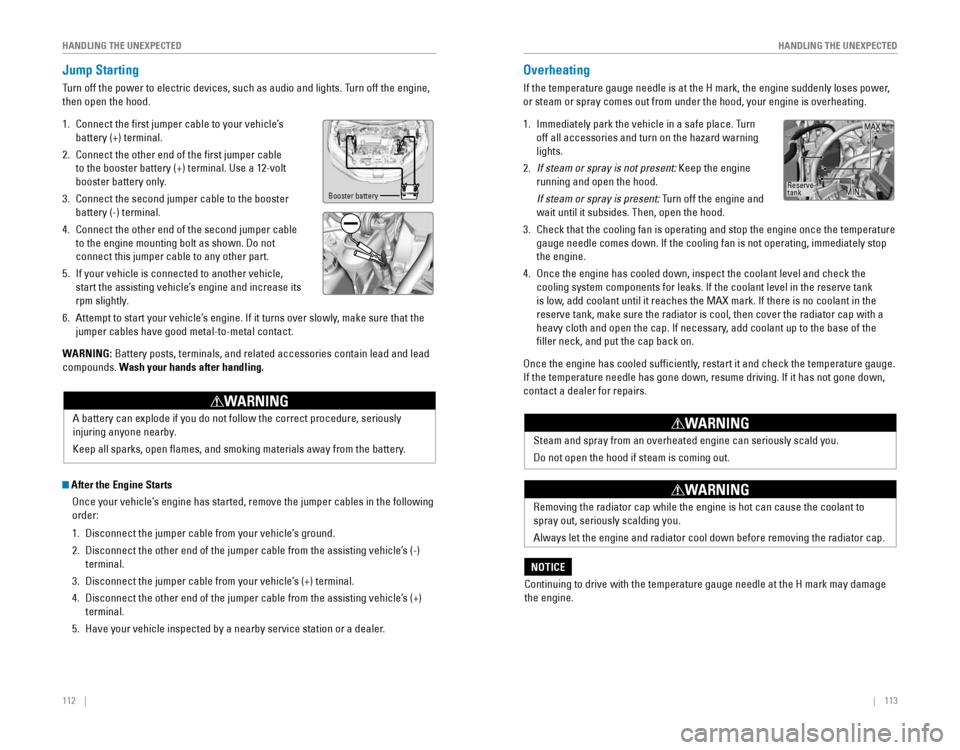
112 || 113
HANDLING THE UNEXPECTED
HANDLING THE UNEXPECTED
After the Engine Starts
Once your vehicle’s engine has started, remove the jumper cables in the following 
order:
1. Disconnect the jumper cable from your vehicle’s ground.
2. Disconnect the other end of the jumper cable from the assisting vehicle’s (-) 
terminal.
3. Disconnect the jumper cable from your vehicle’s (+) terminal.
4. Disconnect the other end of the jumper cable from the assisting vehicle’s (+) 
terminal.
5. Have‚ÄÇyour‚ÄÇvehicle‚ÄÇinspected‚ÄÇby‚ÄÇa‚ÄÇnearby‚ÄÇservice‚ÄÇstation‚ÄÇor‚ÄÇa‚ÄÇdealer.
Overheating
If‚ÄÇthe‚ÄÇtemperature‚ÄÇgauge‚ÄÇneedle‚ÄÇis‚ÄÇat‚ÄÇthe‚ÄÇH‚ÄÇmark,‚ÄÇthe‚ÄÇengine‚ÄÇsuddenly‚ÄÇloses‚ÄÇpower,‚ÄÇ
or steam or spray comes out from under the hood, your engine is overheat\
ing.
1. Immediately‚ÄÇpark‚ÄÇthe‚ÄÇvehicle‚ÄÇin‚ÄÇa‚ÄÇsafe‚ÄÇplace.‚ÄÇTurn‚ÄÇ
off‚ÄÇall‚ÄÇaccessories‚ÄÇand‚ÄÇturn‚ÄÇon‚ÄÇthe‚ÄÇhazard‚ÄÇwarning‚ÄÇ
lights.
2. If‚ÄÇsteam‚ÄÇor‚ÄÇspray‚ÄÇis‚ÄÇnot‚ÄÇpresent: Keep the engine
running and open the hood.
‚ÄÇIf‚ÄÇsteam‚ÄÇor‚ÄÇspray‚ÄÇis‚ÄÇpresent: Turn off the engine and
wait‚ÄÇuntil‚ÄÇit‚ÄÇsubsides.‚ÄÇThen,‚ÄÇopen‚ÄÇthe‚ÄÇhood.
3. Check that the cooling fan is operating and stop the engine once the tem\
perature
gauge‚ÄÇneedle‚ÄÇcomes‚ÄÇdown.‚ÄÇIf‚ÄÇthe‚ÄÇcooling‚ÄÇfan‚ÄÇis‚ÄÇnot‚ÄÇoperating,‚ÄÇimmediately‚ÄÇstop‚ÄÇ
the engine.
4.‚ÄÇOnce‚ÄÇthe‚ÄÇengine‚ÄÇhas‚ÄÇcooled‚ÄÇdown,‚ÄÇinspect‚ÄÇthe‚ÄÇcoolant‚ÄÇlevel‚ÄÇand‚ÄÇcheck‚ÄÇthe‚ÄÇ
cooling‚ÄÇsystem‚ÄÇcomponents‚ÄÇfor‚ÄÇleaks.‚ÄÇIf‚ÄÇthe‚ÄÇcoolant‚ÄÇlevel‚ÄÇin‚ÄÇthe‚ÄÇreserve‚ÄÇtank‚ÄÇ
is‚ÄÇlow,‚ÄÇadd‚ÄÇcoolant‚ÄÇuntil‚ÄÇit‚ÄÇreaches‚ÄÇthe‚ÄÇMAX‚ÄÇmark.‚ÄÇIf‚ÄÇthere‚ÄÇis‚ÄÇno‚ÄÇcoolant‚ÄÇin‚ÄÇthe‚ÄÇ
reserve tank, make sure the radiator is cool, then cover the radiator ca\
p with a
heavy‚ÄÇcloth‚ÄÇand‚ÄÇopen‚ÄÇthe‚ÄÇcap.‚ÄÇIf‚ÄÇnecessary,‚ÄÇadd‚ÄÇcoolant‚ÄÇup‚ÄÇto‚ÄÇthe‚ÄÇbase‚ÄÇof‚ÄÇthe‚ÄÇ
filler‚ÄÇneck,‚ÄÇand‚ÄÇput‚ÄÇthe‚ÄÇcap‚ÄÇback‚ÄÇon.
Once the engine has cooled sufficiently, restart it and check the temperature gauge.
If‚ÄÇthe‚ÄÇtemperature‚ÄÇneedle‚ÄÇhas‚ÄÇgone‚ÄÇdown,‚ÄÇresume‚ÄÇdriving.‚ÄÇIf‚ÄÇit‚ÄÇhas‚ÄÇnot‚ÄÇgone‚ÄÇdown,‚ÄÇ
contact a dealer for repairs.
Reserve
tank MAX
MIN
A‚ÄÇbattery‚ÄÇcan‚ÄÇexplode‚ÄÇif‚ÄÇyou‚ÄÇdo‚ÄÇnot‚ÄÇfollow‚ÄÇthe‚ÄÇcorrect‚ÄÇprocedure,‚ÄÇseriously‚ÄÇ
injuring‚ÄÇanyone‚ÄÇnearby.
Keep‚ÄÇall‚ÄÇsparks,‚ÄÇopen‚ÄÇflames,‚ÄÇand‚ÄÇsmoking‚ÄÇmaterials‚ÄÇaway‚ÄÇfrom‚ÄÇthe‚ÄÇbattery.
WARNING
Jump Starting
Turn off the power to electric devices, such as audio and lights. Turn off the engine,
then open the hood.
1. Connect the first jumper cable to your vehicle’s 
battery‚ÄÇ(+)‚ÄÇterminal.
2. Connect‚ÄÇthe‚ÄÇother‚ÄÇend‚ÄÇof‚ÄÇthe‚ÄÇfirst‚ÄÇjumper‚ÄÇcable‚ÄÇ
to‚ÄÇthe‚ÄÇbooster‚ÄÇbattery‚ÄÇ(+)‚ÄÇterminal.‚ÄÇUse‚ÄÇa‚ÄÇ12-volt‚ÄÇ
booster‚ÄÇbattery‚ÄÇonly.
3. Connect‚ÄÇthe‚ÄÇsecond‚ÄÇjumper‚ÄÇcable‚ÄÇto‚ÄÇthe‚ÄÇbooster‚ÄÇ
battery‚ÄÇ(-)‚ÄÇterminal.
4.‚ÄÇConnect‚ÄÇthe‚ÄÇother‚ÄÇend‚ÄÇof‚ÄÇthe‚ÄÇsecond‚ÄÇjumper‚ÄÇcable‚ÄÇ
to‚ÄÇthe‚ÄÇengine‚ÄÇmounting‚ÄÇbolt‚ÄÇas‚ÄÇshown.‚ÄÇDo‚ÄÇnot‚ÄÇ
connect‚ÄÇthis‚ÄÇjumper‚ÄÇcable‚ÄÇto‚ÄÇany‚ÄÇother‚ÄÇpart.
5. If‚ÄÇyour‚ÄÇvehicle‚ÄÇis‚ÄÇconnected‚ÄÇto‚ÄÇanother‚ÄÇvehicle,‚ÄÇ
start the assisting vehicle’s engine and increase its
rpm slightly.
6. Attempt to start your vehicle’s engine. If it turns over slowly, make sure that the 
jumper‚ÄÇcables‚ÄÇhave‚ÄÇgood‚ÄÇmetal-to-metal‚ÄÇcontact.
WARNING: Battery posts, terminals, and related accessories contain lead and lead\
compounds. Wash your hands after handling.
Booster‚ÄÇbattery
Steam and spray from an overheated engine can seriously scald you.
Do‚ÄÇnot‚ÄÇopen‚ÄÇthe‚ÄÇhood‚ÄÇif‚ÄÇsteam‚ÄÇis‚ÄÇcoming‚ÄÇout.
WARNING
Removing the radiator cap while the engine is hot can cause the coolant \
to
spray out, seriously scalding you.
Always‚ÄÇlet‚ÄÇthe‚ÄÇengine‚ÄÇand‚ÄÇradiator‚ÄÇcool‚ÄÇdown‚ÄÇbefore‚ÄÇremoving‚ÄÇthe‚ÄÇradiator‚ÄÇcap.
WARNING
Continuing to drive with the temperature gauge needle at the H mark may \
damage
the engine.
NOTICE
Page 62 of 80
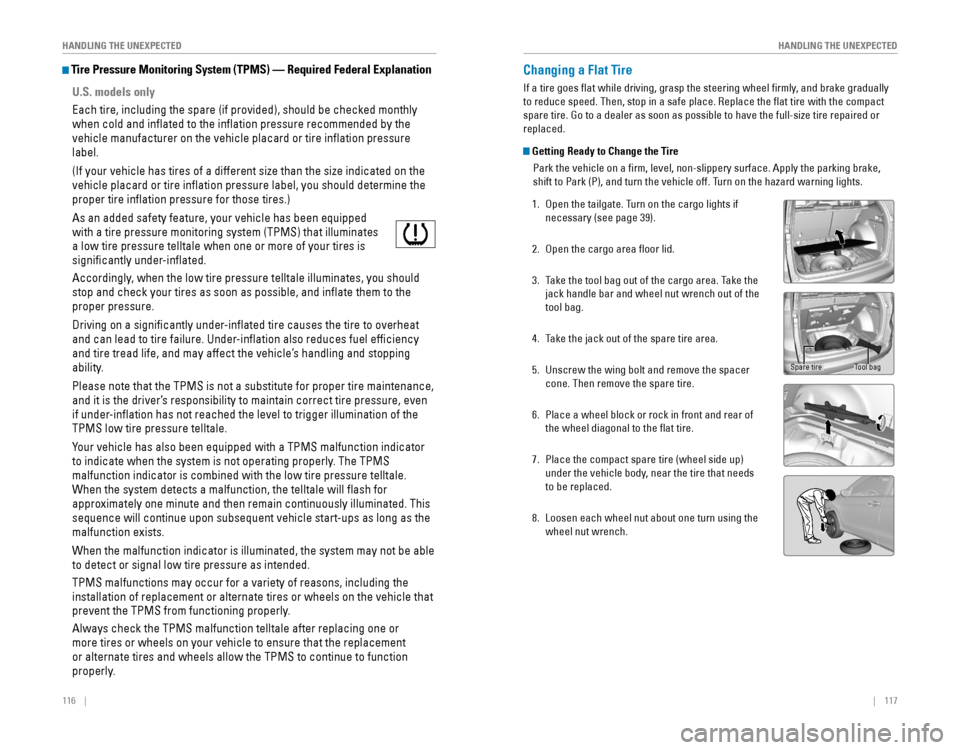
116 ||‚ÄÇ‚ÄÇ‚ÄÇ‚ÄÇ117
HANDLING THE UNEXPECTED
HANDLING THE UNEXPECTED
Tire Pressure Monitoring System (TPMS) — Required Federal Explanatio\
n
U.S. models only
Each‚ÄÇtire,‚ÄÇincluding‚ÄÇthe‚ÄÇspare‚ÄÇ(if‚ÄÇprovided),‚ÄÇshould‚ÄÇbe‚ÄÇchecked‚ÄÇmonthly‚ÄÇ
when‚ÄÇcold‚ÄÇand‚ÄÇinflated‚ÄÇto‚ÄÇthe‚ÄÇinflation‚ÄÇpressure‚ÄÇrecommended‚ÄÇby‚ÄÇthe‚ÄÇ
vehicle manufacturer on the vehicle placard or tire inflation pressure\
label.
(If‚ÄÇyour‚ÄÇvehicle‚ÄÇhas‚ÄÇtires‚ÄÇof‚ÄÇa‚ÄÇdifferent‚ÄÇsize‚ÄÇthan‚ÄÇthe‚ÄÇsize‚ÄÇindicated‚ÄÇon‚ÄÇthe‚ÄÇ
vehicle‚ÄÇplacard‚ÄÇor‚ÄÇtire‚ÄÇinflation‚ÄÇpressure‚ÄÇlabel,‚ÄÇyou‚ÄÇshould‚ÄÇdetermine‚ÄÇthe‚ÄÇ
proper tire inflation pressure for those tires.)
As‚ÄÇan‚ÄÇadded‚ÄÇsafety‚ÄÇfeature,‚ÄÇyour‚ÄÇvehicle‚ÄÇhas‚ÄÇbeen‚ÄÇequipped‚ÄÇ
with a tire pressure monitoring system (TPMS) that illuminates
a low tire pressure telltale when one or more of your tires is
significantly under-inflated.
Accordingly, when the low tire pressure telltale illuminates, you should
stop‚ÄÇand‚ÄÇcheck‚ÄÇyour‚ÄÇtires‚ÄÇas‚ÄÇsoon‚ÄÇas‚ÄÇpossible,‚ÄÇand‚ÄÇinflate‚ÄÇthem‚ÄÇto‚ÄÇthe‚ÄÇ
proper pressure.
Driving‚ÄÇon‚ÄÇa‚ÄÇsignificantly‚ÄÇunder-inflated‚ÄÇtire‚ÄÇcauses‚ÄÇthe‚ÄÇtire‚ÄÇto‚ÄÇoverheat‚ÄÇ
and can lead to tire failure. Under-inflation also reduces fuel efficiency
and tire tread life, and may affect the vehicle’s handling and stopping
ability.
Please‚ÄÇnote‚ÄÇthat‚ÄÇthe‚ÄÇTPMS‚ÄÇis‚ÄÇnot‚ÄÇa‚ÄÇsubstitute‚ÄÇfor‚ÄÇproper‚ÄÇtire‚ÄÇmaintenance,‚ÄÇ
and it is the driver’s responsibility to maintain correct tire pressure, even 
if under-inflation has not reached the level to trigger illumination of the
TPMS low tire pressure telltale.
Your‚ÄÇvehicle‚ÄÇhas‚ÄÇalso‚ÄÇbeen‚ÄÇequipped‚ÄÇwith‚ÄÇa‚ÄÇTPMS‚ÄÇmalfunction‚ÄÇindicator‚ÄÇ
to indicate when the system is not operating properly. The TPMS
malfunction‚ÄÇindicator‚ÄÇis‚ÄÇcombined‚ÄÇwith‚ÄÇthe‚ÄÇlow‚ÄÇtire‚ÄÇpressure‚ÄÇtelltale.‚ÄÇ
When the system detects a malfunction, the telltale will flash for
approximately one minute and then remain continuously illuminated. This \
sequence‚ÄÇwill‚ÄÇcontinue‚ÄÇupon‚ÄÇsubsequent‚ÄÇvehicle‚ÄÇstart-ups‚ÄÇas‚ÄÇlong‚ÄÇas‚ÄÇthe‚ÄÇ
malfunction exists.
When‚ÄÇthe‚ÄÇmalfunction‚ÄÇindicator‚ÄÇis‚ÄÇilluminated,‚ÄÇthe‚ÄÇsystem‚ÄÇmay‚ÄÇnot‚ÄÇbe‚ÄÇable‚ÄÇ
to detect or signal low tire pressure as intended.
TPMS malfunctions may occur for a variety of reasons, including the
installation of replacement or alternate tires or wheels on the vehicle \
that
prevent the TPMS from functioning properly.
Always check the TPMS malfunction telltale after replacing one or
more tires or wheels on your vehicle to ensure that the replacement
or alternate tires and wheels allow the TPMS to continue to function
properly.
Changing a Flat Tire
If‚ÄÇa‚ÄÇtire‚ÄÇgoes‚ÄÇflat‚ÄÇwhile‚ÄÇdriving,‚ÄÇgrasp‚ÄÇthe‚ÄÇsteering‚ÄÇwheel‚ÄÇfirmly,‚ÄÇand‚ÄÇbrake‚ÄÇgradually‚ÄÇ
to reduce speed. Then, stop in a safe place. Replace the flat tire wit\
h the compact
spare‚ÄÇtire.‚ÄÇGo‚ÄÇto‚ÄÇa‚ÄÇdealer‚ÄÇas‚ÄÇsoon‚ÄÇas‚ÄÇpossible‚ÄÇto‚ÄÇhave‚ÄÇthe‚ÄÇfull-size‚ÄÇtire‚ÄÇrepaired‚ÄÇor‚ÄÇ
replaced.
Getting Ready to Change the Tire
Park‚ÄÇthe‚ÄÇvehicle‚ÄÇon‚ÄÇa‚ÄÇfirm,‚ÄÇlevel,‚ÄÇnon-slippery‚ÄÇsurface.‚ÄÇApply‚ÄÇthe‚ÄÇparking‚ÄÇbrake,‚ÄÇ
shift‚ÄÇto‚ÄÇPark‚ÄÇ(P),‚ÄÇand‚ÄÇturn‚ÄÇthe‚ÄÇvehicle‚ÄÇoff.‚ÄÇTurn‚ÄÇon‚ÄÇthe‚ÄÇhazard‚ÄÇwarning‚ÄÇlights.
1. Open the tailgate. Turn on the cargo lights if
necessary (see page 39).
2. Open the cargo area floor lid.
3. Take‚ÄÇthe‚ÄÇtool‚ÄÇbag‚ÄÇout‚ÄÇof‚ÄÇthe‚ÄÇcargo‚ÄÇarea.‚ÄÇTake‚ÄÇthe‚ÄÇ
jack‚ÄÇhandle‚ÄÇbar‚ÄÇand‚ÄÇwheel‚ÄÇnut‚ÄÇwrench‚ÄÇout‚ÄÇof‚ÄÇthe‚ÄÇ
tool‚ÄÇbag.
4.‚ÄÇTake the jack out of the spare tire area.
5. Unscrew‚ÄÇthe‚ÄÇwing‚ÄÇbolt‚ÄÇand‚ÄÇremove‚ÄÇthe‚ÄÇspacer‚ÄÇ
cone. Then remove the spare tire.
6. Place‚ÄÇa‚ÄÇwheel‚ÄÇblock‚ÄÇor‚ÄÇrock‚ÄÇin‚ÄÇfront‚ÄÇand‚ÄÇrear‚ÄÇof‚ÄÇ
the wheel diagonal to the flat tire.
7.‚ÄÇPlace the compact spare tire (wheel side up)
under‚ÄÇthe‚ÄÇvehicle‚ÄÇbody,‚ÄÇnear‚ÄÇthe‚ÄÇtire‚ÄÇthat‚ÄÇneeds‚ÄÇ
to‚ÄÇbe‚ÄÇreplaced.
8. Loosen‚ÄÇeach‚ÄÇwheel‚ÄÇnut‚ÄÇabout‚ÄÇone‚ÄÇturn‚ÄÇusing‚ÄÇthe‚ÄÇ
wheel nut wrench.
Tool‚ÄÇbagSpare tire
Page 65 of 80
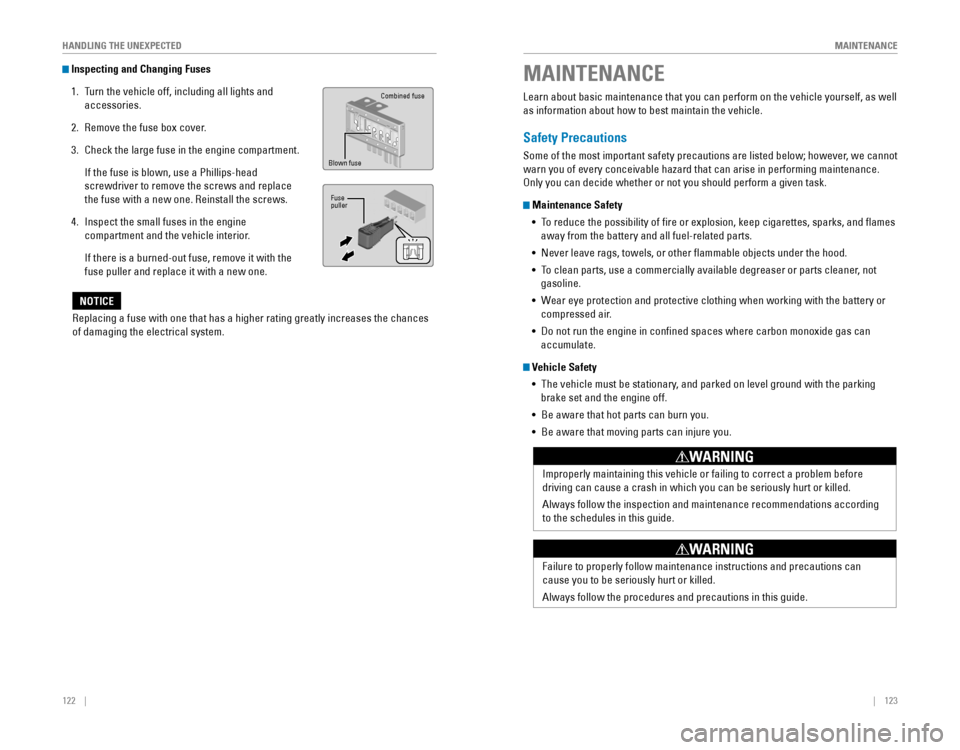
122 || 123
MAINTENANCE
HANDLING THE UNEXPECTED
Inspecting and Changing Fuses
1. Turn the vehicle off, including all lights and
accessories.
2. Remove‚ÄÇthe‚ÄÇfuse‚ÄÇbox‚ÄÇcover.
3. Check the large fuse in the engine compartment.
‚ÄÇIf‚ÄÇthe‚ÄÇfuse‚ÄÇis‚ÄÇblown,‚ÄÇuse‚ÄÇa‚ÄÇPhillips-head‚ÄÇ
screwdriver to remove the screws and replace
the fuse with a new one. Reinstall the screws.
4.‚ÄÇInspect‚ÄÇthe‚ÄÇsmall‚ÄÇfuses‚ÄÇin‚ÄÇthe‚ÄÇengine‚ÄÇ
compartment and the vehicle interior.
‚ÄÇIf‚ÄÇthere‚ÄÇis‚ÄÇa‚ÄÇburned-out‚ÄÇfuse,‚ÄÇremove‚ÄÇit‚ÄÇwith‚ÄÇthe‚ÄÇ
fuse puller and replace it with a new one.
Replacing a fuse with one that has a higher rating greatly increases the\
chances
of damaging the electrical system.
NOTICE
Blown fuse
Combined‚ÄÇfuse
Fuse
puller
Learn‚ÄÇabout‚ÄÇbasic‚ÄÇmaintenance‚ÄÇthat‚ÄÇyou‚ÄÇcan‚ÄÇperform‚ÄÇon‚ÄÇthe‚ÄÇvehicle‚ÄÇyourself,‚ÄÇas‚ÄÇwell‚ÄÇ
as‚ÄÇinformation‚ÄÇabout‚ÄÇhow‚ÄÇto‚ÄÇbest‚ÄÇmaintain‚ÄÇthe‚ÄÇvehicle.
Safety Precautions
Some‚ÄÇof‚ÄÇthe‚ÄÇmost‚ÄÇimportant‚ÄÇsafety‚ÄÇprecautions‚ÄÇare‚ÄÇlisted‚ÄÇbelow;‚ÄÇhowever,‚ÄÇwe‚ÄÇcannot‚ÄÇ
warn‚ÄÇyou‚ÄÇof‚ÄÇevery‚ÄÇconceivable‚ÄÇhazard‚ÄÇthat‚ÄÇcan‚ÄÇarise‚ÄÇin‚ÄÇperforming‚ÄÇmaintenance.‚ÄÇ
Only you can decide whether or not you should perform a given task.
Maintenance Safety • 
To‚ÄÇreduce‚ÄÇthe‚ÄÇpossibility‚ÄÇof‚ÄÇfire‚ÄÇor‚ÄÇexplosion,‚ÄÇkeep‚ÄÇcigarettes,‚ÄÇsparks,‚ÄÇand‚ÄÇflames‚ÄÇ
away‚ÄÇfrom‚ÄÇthe‚ÄÇbattery‚ÄÇand‚ÄÇall‚ÄÇfuel-related‚ÄÇparts.
• Never leave rags, towels, or other flammable objects under the hood.
• To clean parts, use a commercially available degreaser or parts cleaner, not 
gasoline.
• 
Wear‚ÄÇeye‚ÄÇprotection‚ÄÇand‚ÄÇprotective‚ÄÇclothing‚ÄÇwhen‚ÄÇworking‚ÄÇwith‚ÄÇthe‚ÄÇbattery‚ÄÇor‚ÄÇ
compressed air.
• 
Do‚ÄÇnot‚ÄÇrun‚ÄÇthe‚ÄÇengine‚ÄÇin‚ÄÇconfined‚ÄÇspaces‚ÄÇwhere‚ÄÇcarbon‚ÄÇmonoxide‚ÄÇgas‚ÄÇcan‚ÄÇ
accumulate.
Vehicle Safety • 
The‚ÄÇvehicle‚ÄÇmust‚ÄÇbe‚ÄÇstationary,‚ÄÇand‚ÄÇparked‚ÄÇon‚ÄÇlevel‚ÄÇground‚ÄÇwith‚ÄÇthe‚ÄÇparking‚ÄÇ
brake‚ÄÇset‚ÄÇand‚ÄÇthe‚ÄÇengine‚ÄÇoff.
• Be aware that hot parts can burn you.
•  Be aware that moving parts can injure you.
MAINTENANCE
Improperly‚ÄÇmaintaining‚ÄÇthis‚ÄÇvehicle‚ÄÇor‚ÄÇfailing‚ÄÇto‚ÄÇcorrect‚ÄÇa‚ÄÇproblem‚ÄÇbefore‚ÄÇ
driving‚ÄÇcan‚ÄÇcause‚ÄÇa‚ÄÇcrash‚ÄÇin‚ÄÇwhich‚ÄÇyou‚ÄÇcan‚ÄÇbe‚ÄÇseriously‚ÄÇhurt‚ÄÇor‚ÄÇkilled.‚ÄÇ
Always follow the inspection and maintenance recommendations according
to the schedules in this guide.
WARNING
Failure to properly follow maintenance instructions and precautions can \
cause‚ÄÇyou‚ÄÇto‚ÄÇbe‚ÄÇseriously‚ÄÇhurt‚ÄÇor‚ÄÇkilled.
Always follow the procedures and precautions in this guide.
WARNING
Page 79 of 80
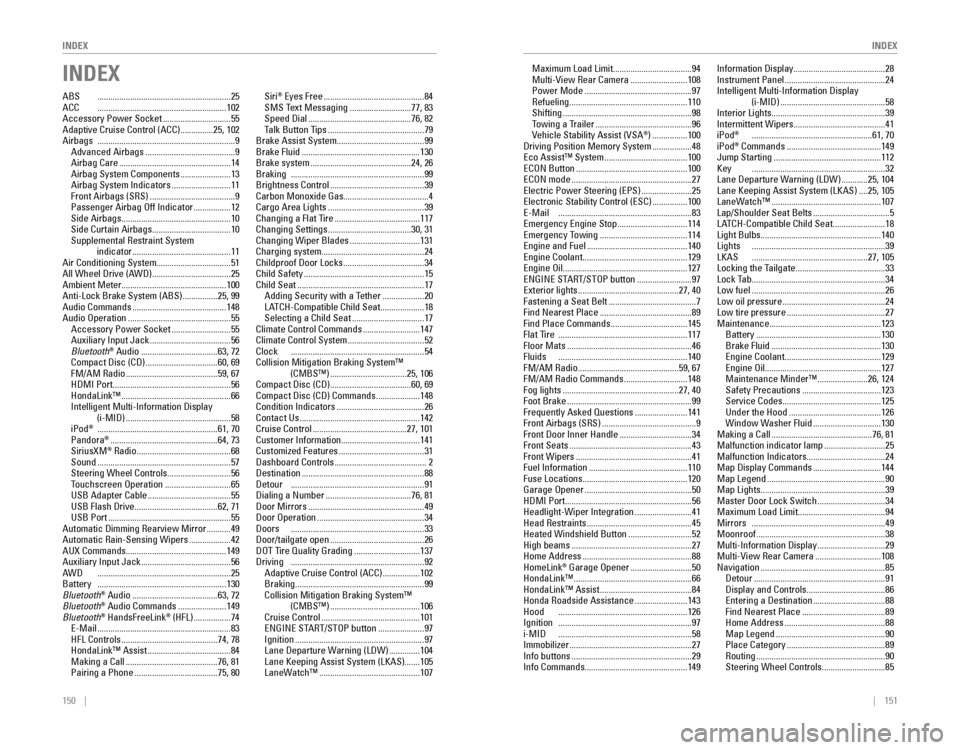
150 || 151
INDEX
INDEX
INDEX
ABS .............................................................25ACC ...........................................................102
Accessory Power Socket ...............................55
Adaptive Cruise Control (ACC) ...............25, 102Airbags‚ÄÇ ...............................................................9Advanced‚ÄÇAirbags .........................................9Airbag‚ÄÇCare ...................................................14Airbag‚ÄÇSystem‚ÄÇComponents .......................13Airbag‚ÄÇSystem‚ÄÇIndicators ...........................11Front‚ÄÇAirbags‚ÄÇ(SRS) .......................................9Passenger‚ÄÇAirbag‚ÄÇOff‚ÄÇIndicator .................12Side‚ÄÇAirbags ..................................................10Side‚ÄÇCurtain‚ÄÇAirbags ....................................10
Supplemental Restraint System indicator
.............................................11
Air Conditioning System ..................................51
All‚ÄÇWheel‚ÄÇDrive‚ÄÇ(AWD) ....................................25Ambient‚ÄÇMeter................................................ 100
Anti-Lock Brake System (ABS) ................25, 99
Audio Commands ...........................................148
Audio Operation ...............................................55
Accessory Power Socket ...........................55Auxiliary‚ÄÇInput‚ÄÇJack .....................................56
Bluetooth® Audio ...................................63, 72Compact Disc (CD) .................................60, 69FM/AM Radio ..........................................59, 67HDMI Port ......................................................56
HondaLink‚Ñ¢ ..................................................66Intelligent‚ÄÇMulti-Information‚ÄÇDisplay
(i-MID) ................................................58
iPod® .......................................................61, 70Pandora® .................................................64, 73SiriusXM® Radio ...........................................68Sound .............................................................57
Steering Wheel Controls .............................56
Touchscreen Operation ..............................65USB‚ÄÇAdapter‚ÄÇCable ......................................55USB‚ÄÇFlash‚ÄÇDrive ......................................62,‚ÄÇ71USB Port ........................................................55Automatic‚ÄÇDimming‚ÄÇRearview‚ÄÇMirror ...........49
Automatic Rain-Sensing Wipers ...................42
AUX Commands .............................................. 149
Auxiliary‚ÄÇInput‚ÄÇJack .........................................56AWD‚ÄÇ .............................................................25Battery ...........................................................130
Bluetooth® Audio .......................................63, 72Bluetooth® Audio Commands ......................149
Bluetooth® HandsFreeLink® (HFL) .................74E-Mail  .............................................................83
HFL Controls ............................................74,‚ÄÇ78HondaLink‚Ñ¢ Assist ......................................84
Making a Call ..........................................76,‚ÄÇ81Pairing a Phone ......................................75,‚ÄÇ80
Siri® Eyes Free ..............................................84
SMS Text Messaging ............................77,‚ÄÇ83Speed‚ÄÇDial ...............................................76,‚ÄÇ82Talk Button Tips ............................................79
Brake Assist System ........................................ 99
Brake Fluid
......................................................130
Brake system ..............................................24,‚ÄÇ26Braking .............................................................99
Brightness Control ...........................................39Carbon‚ÄÇMonoxide‚ÄÇGas....................................... 4
Cargo Area Lights ............................................39
Changing a Flat Tire .......................................117
Changing Settings ......................................30, 31
Changing Wiper Blades ................................131
Charging system ............................................... 24
Childproof‚ÄÇDoor‚ÄÇLocks .....................................34
Child Safety .......................................................15
Child Seat ..........................................................17
Adding Security with a Tether ...................20LATCH-Compatible‚ÄÇChild‚ÄÇSeat ....................18
Selecting a Child Seat .................................17
Climate Control Commands ..........................147
Climate Control System ...................................52Clock .............................................................54
Collision Mitigation Braking System‚Ñ¢ (CMBS‚Ñ¢)
...................................25, 106Compact‚ÄÇDisc‚ÄÇ(CD) .....................................60, 69Compact‚ÄÇDisc‚ÄÇ(CD)‚ÄÇCommands ....................148Condition‚ÄÇIndicators ........................................26
Contact Us .......................................................142
Cruise Control ...........................................27,‚ÄÇ101Customer‚ÄÇInformation.................................... 141Customized‚ÄÇFeatures .......................................31Dashboard‚ÄÇControls .......................................... 2
Destination ........................................................88Detour‚ÄÇ .............................................................91Dialing‚ÄÇa‚ÄÇNumber .......................................76,‚ÄÇ81Door‚ÄÇMirrors .....................................................49Door‚ÄÇOperation .................................................34Doors‚ÄÇ .............................................................33Door/tailgate‚ÄÇopen ...........................................26DOT‚ÄÇTire‚ÄÇQuality‚ÄÇGrading ..............................137Driving‚ÄÇ .............................................................92
Adaptive Cruise Control (ACC) .................102
Braking ...........................................................99
Collision Mitigation Braking System‚Ñ¢ (CMBS‚Ñ¢)
.........................................106
Cruise Control .............................................101ENGINE‚ÄÇSTART/STOP‚ÄÇbutton .....................97
Ignition ...........................................................97Lane‚ÄÇDeparture‚ÄÇWarning‚ÄÇ(LDW) ..............104
Lane Keeping Assist System (LKAS) .......105
LaneWatch‚Ñ¢ ..............................................107 Maximum Load Limit
....................................94
Multi-View Rear Camera ..........................108
Power Mode .................................................97
Refueling ......................................................110
Shifting ...........................................................98
Towing a Trailer ............................................96Vehicle Stability Assist (VSA®) ................100Driving Position Memory System ..................48Eco Assist™ System ......................................100ECON Button ...................................................100ECON mode .......................................................27Electric Power Steering (EPS) .......................25Electronic Stability Control (ESC) ................100E-Mail  .............................................................83Emergency Engine Stop ................................114Emergency Towing ........................................114Engine and Fuel ..............................................140Engine Coolant................................................ 129Engine Oil......................................................... 127ENGINE START/STOP button .........................97Exterior lights ..............................................27, 40Fastening a Seat Belt ........................................7
Find Nearest Place ..........................................89
Find Place Commands ...................................145Flat Tire ...........................................................117
Floor Mats .........................................................46Fluids ...........................................................140FM/AM‚ÄÇRadio ..............................................59,‚ÄÇ67FM/AM‚ÄÇRadio‚ÄÇCommands .............................148
Fog lights .....................................................27,‚ÄÇ40Foot Brake .........................................................99Frequently‚ÄÇAsked‚ÄÇQuestions ........................141Front‚ÄÇAirbags‚ÄÇ(SRS) ...........................................9Front‚ÄÇDoor‚ÄÇInner‚ÄÇHandle .................................34
Front Seats ........................................................43
Front Wipers .....................................................41Fuel‚ÄÇInformation .............................................110
Fuse Locations ................................................ 120
Garage Opener
.................................................50HDMI‚ÄÇPort.......................................................... 56Headlight-Wiper‚ÄÇIntegration ..........................41
Head Restraints ................................................45
Heated Windshield Button .............................52High‚ÄÇbeams .......................................................27
Home Address ..................................................88
HomeLink® Garage Opener ............................50
HondaLink‚Ñ¢ ......................................................66
HondaLink‚Ñ¢ Assist ..........................................84
Honda Roadside Assistance ........................143Hood ...........................................................126Ignition‚ÄÇ .............................................................97i-MID‚ÄÇ .............................................................58
Immobilizer ........................................................27Info‚ÄÇbuttons .......................................................29Info‚ÄÇCommands............................................... 149
Information‚ÄÇDisplay..........................................28Instrument‚ÄÇPanel ..............................................24Intelligent‚ÄÇMulti-Information‚ÄÇDisplay
(i-MID) ................................................58Interior‚ÄÇLights.................................................... 39Intermittent‚ÄÇWipers..........................................41
iPod® .......................................................61, 70iPod® Commands ...........................................149
Jump Starting .................................................112Key .............................................................32Lane‚ÄÇDeparture‚ÄÇWarning‚ÄÇ(LDW) ............25,‚ÄÇ104Lane Keeping Assist System (LKAS) ....25, 105
LaneWatch‚Ñ¢ ..................................................107Lap/Shoulder‚ÄÇSeat‚ÄÇBelts ...................................5LATCH-Compatible‚ÄÇChild‚ÄÇSeat ........................18Light‚ÄÇBulbs....................................................... 140Lights .............................................................39LKAS .....................................................27,‚ÄÇ105Locking the Tailgate .........................................33Lock‚ÄÇTab .............................................................34Low fuel .............................................................26
Low oil pressure ...............................................24
Low tire pressure .............................................27
Maintenance ................................................... 123
Battery
.........................................................130
Brake Fluid ..................................................130Engine‚ÄÇCoolant ............................................129Engine‚ÄÇOil .....................................................127
Maintenance Minder‚Ñ¢ .......................26,‚ÄÇ124Safety Precautions ....................................123
Service Codes .............................................125
Under the Hood ..........................................126
Window Washer Fluid ...............................130
Making a Call ..............................................76,‚ÄÇ81Malfunction indicator lamp ............................25Malfunction‚ÄÇIndicators.................................... 24Map‚ÄÇDisplay‚ÄÇCommands ...............................144
Map Legend ......................................................90
Map Lights ......................................................... 39
Master‚ÄÇDoor‚ÄÇLock‚ÄÇSwitch ...............................34
Maximum Load Limit ........................................ 94
Mirrors .............................................................49
Moonroof ...........................................................38Multi-Information‚ÄÇDisplay ...............................29
Multi-View Rear Camera ..............................108
Navigation .........................................................85
Detour ............................................................91Display‚ÄÇand‚ÄÇControls ....................................86Entering‚ÄÇa‚ÄÇDestination .................................88
Find Nearest Place ......................................89
Home Address ..............................................88
Map Legend ..................................................90
Place Category .............................................89
Routing ...........................................................90
Steering Wheel Controls .............................85